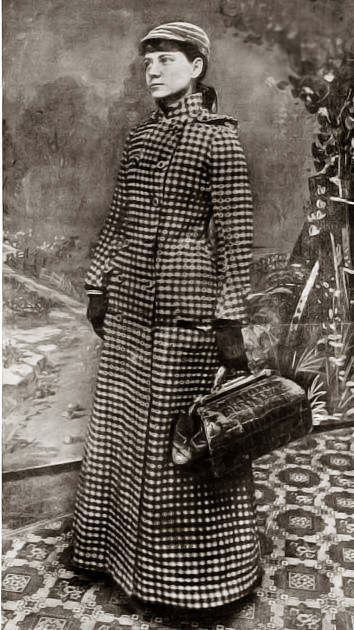
Elizabeth Jane Cochran, better known by her pen name, Nellie Bly, was born on May 5, 1864 in Cochran’s Mills, Pennsylvania. She left school in 1871 due to the lack of funds after her father died. In 1880, her mother moved the family to Pittsburgh for better job opportunities. It was here that Elizabeth would get her start in newspapers.
When a local newspaper, the Pittsburgh Dispatch, published an article entitled, “What Girls Are Good For”, that reported girls were principally for birthing children and keeping houses, Elizabeth felt prompted to respond under the pseudonym “Lonely Orphan Girl”. The editor of the Pittsburgh Dispatch was impressed by her passion and ran an advertisement asking for the author to identify herself. When she introduced herself to the editor, he offered her the opportunity to write a piece for the newspaper. The editor was so impressed by this piece that he offered her a full time job. At the time it was customary for women who were newspaper writers to use pen names, and the editor chose “Nellie Bly” for Elizabeth and Nellie Bly newspaper journalist was born.
As a writer Bly focused her early work on the lives of working women, writing investigative articles on women factory workers. However, the newspaper soon received complaints from the factory owners about her writing. Due to these complaints she was reassigned to women’s pages to cover fashion, society, and gardening, which was the usual role for women journalists, but she was dissatisfied with this work. She then traveled to Mexico to serve as a foreign correspondent. At age 21 she was determined to do something no girl had done before. She soon left for Mexico, spending nearly half a year reporting the lives and customs of the Mexican people; her dispatches later were published in book form as Six Months in Mexico. In one report, she protested the imprisonment of a local journalist for criticizing the Mexican government, then a dictatorship under Porfirio Díaz. When Mexican authorities learned of Bly's report, they threatened her with arrest, prompting her to flee the country.
When she returned to Pittsburgh she was once again given theater and arts reporting. Bly left the Pittsburgh Dispatch in 1887 for New York City. Penniless after four months, she talked her way into the offices of Joseph Pulitzer's newspaper the New York World, and took an undercover assignment for which she agreed to feign insanity to investigate reports of brutality and neglect at the Women's Lunatic Asylum on Blackwell's Island. It was not an easy task for Bly to be admitted to the Asylum: She first decided to check herself into a boarding house called Temporary Homes for Females. She stayed up all night long to give herself the wide-eyed look of a disturbed woman, and began making accusations that the other boarders were insane. She refused to go to bed, and eventually scared so many of the other boarders that the police were called to take her to the nearby courthouse. Once examined by a police officer, a judge, and a doctor, Bly was taken to Blackwell's Island. Once committed to the asylum, Bly experienced the deplorable conditions firsthand. After ten days, the asylum released Bly at the New York World's behest. Her report, later published in book form as Ten Days in a Mad-House, caused a sensation, prompted the asylum to implement reforms, and made her famous.
In 1895, Bly married millionaire manufacturer Robert Seaman. Bly was 31 and Seaman was 73 when they married. Due to her husband's failing health, she left journalism and succeeded her husband as head of the Iron Clad Manufacturing Co., which made steel containers such as milk cans and boilers. There are claims that she invented the steel barrel that was the model for the 55-gallon oil drum still in widespread use in the United States. She was an inventor in her own right and received a U.S. patent for a novel milk can and for a stacking garbage can, both under her name Elizabeth Cochrane Seaman. In 1904, her husband Robert Seaman died. She ran the company until she died of pneumonia at St. Mark's Hospital in New York City in 1922 at age 57.
If you would like to learn more about this important woman in history.



Add a comment to: Women in History – Nellie Bly